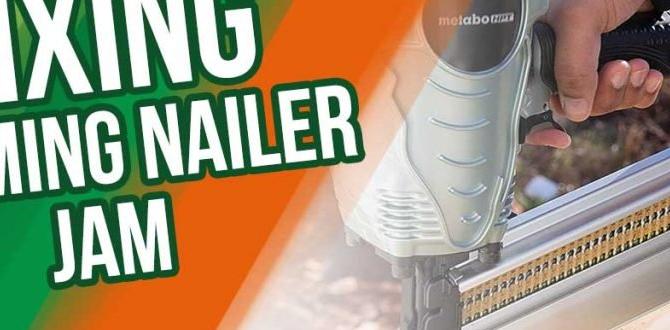Quick Summary:
Regularly cleaning the inside of your nailer prevents jams, improves performance, and extends its lifespan. This guide provides simple, expert steps to safely and effectively clean your nailer, ensuring it works like new for all your projects.
Hey there, fellow makers and DIYers! Jack Shaffer here from Nailerguy. Have you ever had your nailer give you a little grief? Maybe it’s jammed unexpectedly, or the nails aren’t fully setting like they used to. It’s a common frustration, but the good news is that often, the solution is simpler than you think. It usually comes down to a bit of routine maintenance – specifically, keeping the inside of your nailer sparkling clean.
Don’t worry if you’ve never tackled this before. We’ll walk through it together, step-by-step. Cleaning your nailer isn’t just about fixing immediate problems; it’s about preventing them and making sure your trusty tool is always ready for action. By the end of this guide, you’ll know exactly how to give your nailer a thorough internal clean, ensuring it performs at its best and lasts for years to come.
Table of Contents
Why Cleaning Your Nailer Matters So Much
Think of your nailer like any other precision tool. It has moving parts that work hard, and over time, these parts can accumulate debris. This debris can be anything from sawdust and wood chips to old lubricant or even tiny bits of metal. When this gunk builds up inside, it can cause all sorts of headaches.
The most common issues are:
- Nail Jams: This is the big one! Debris can obstruct the path of the nail, leading to frustrating jams that stop your work dead in its tracks.
- Reduced Power: A dirty nailer might not drive nails with the same force. You might find nails sticking out slightly after firing, requiring you to finish them with a hammer – not ideal!
- Inconsistent Firing: Sometimes, a dirty mechanism can lead to misfires or uneven nail placement.
- Wear and Tear: Over time, debris can act like sandpaper, wearing down internal components and shortening the overall lifespan of your tool.
- Damage to Fasteners: In some cases, a dirty nailer can even bend nails as they are driven.
By taking a little time to clean the inside of your nailer, you’re investing in its reliability and longevity. It’s a small effort that pays off in big ways, keeping your projects moving smoothly and efficiently. Plus, it’s a great way to get to know your tool better!
What You’ll Need: Your Nailer Cleaning Toolkit
Before we dive into the cleaning process, let’s gather the necessary supplies. Having everything ready will make the job much smoother and quicker. You don’t need a ton of specialized equipment; most of these items are common household or workshop staples.
Essential Cleaning Supplies:
- Safety Glasses: Always protect your eyes, especially when working with tools that can release small particles.
- Gloves: To keep your hands clean and protect them from any lubricants or solvents.
- Compressed Air: This is your best friend for blowing out loose debris. A can of compressed air for electronics works, but an air compressor with a blow nozzle is even better for more power.
- Nailer Lubricant: Specifically designed for pneumatic nailers. Using the wrong type of oil can damage seals. For corded or battery-powered nailers, refer to the manufacturer’s manual.
- Lint-Free Cloths or Rags: For wiping down parts and absorbing excess lubricant.
- Small Brush (Nylon or Bristle): A toothbrush or a small parts brush is perfect for gently scrubbing away stubborn grime. Avoid stiff wire brushes inside the delicate mechanisms.
- Cotton Swabs: Excellent for cleaning tight nooks and crannies.
- Penetrating Oil or Degreaser (Optional): For very stubborn, built-up grime. Use sparingly and ensure it’s compatible with your nailer’s materials. Always wipe away thoroughly. An example of a good penetrating oil is WD-40 Specialist Penetrant.
- Manufacturer’s Manual: Crucial for specific instructions regarding your nailer model.
Make sure you’re working in a well-ventilated area, especially if you decide to use any cleaning solvents. Safety first, always!
Step-by-Step Guide: How to Clean Inside Your Nailer
Now, let’s get down to business! We’ll break this down into easy-to-follow steps. Remember to always consult your nailer’s manual for specific details related to your model, as pneumatic, electric, and battery-powered nailers can have slightly different procedures.
Step 1: Safety First – Disconnect the Power!
This is the absolute most critical step. Before you do anything else, ensure the nailer cannot accidentally fire.
- For Pneumatic Nailers: Disconnect the air hose completely from the tool.
- For Electric Nailers: Unplug the power cord from the outlet.
- For Battery-Powered Nailers: Remove the battery pack from the tool.
Double-check that there are no nails loaded in the magazine. It’s also a good habit to cycle the mechanism a few times (without power) to ensure it’s completely disengaged.
Step 2: Access the Internal Mechanism
Most nailers have a cover or panel that allows access to the internal firing mechanism and piston. This is often located at the top or rear of the tool.
- Locate Fasteners: Look for screws or clips that hold this access panel in place.
- Remove Panel: Carefully unscrew or unclip the panel. Keep the screws in a safe place, like a small tray or magnetic dish, so they don’t get lost.
- Identify Key Parts: Once open, you’ll typically see the piston, O-rings, and spring. This is the area we need to clean.
Again, refer to your manual. Some higher-end or specific models might have slightly different access points or require more detailed disassembly. If you’re unsure, it’s better to stop and consult the manual or a professional.
Step 3: Blow Out Loose Debris
This is where your compressed air comes in handy. With the internal chamber exposed, blast away any loose dust, wood particles, or other bits of debris.
- Target Areas: Focus on the piston cylinder, around the piston itself, and any other accessible cavities.
- Angle of Attack: Hold the nozzle at an angle to help push debris out of the tool, rather than deeper into it. Wear your safety glasses, as debris can fly!
- Repeat if Necessary: Give it a good, thorough blast. You might be surprised how much comes out.
If you don’t have a dedicated air compressor, a can of compressed air will work for most of the loose dust. You might need to be a bit more strategic with the nozzle.
Step 4: Clean the Piston and Cylinder
The piston is the part that moves up and down to drive the nail. It can get quite dirty.
- Inspect the Piston: Gently pull the piston out (if it doesn’t come out easily, consult your manual). Look for any grime or carbon buildup.
- Wipe Down: Use a clean, lint-free cloth to wipe the piston rod and the sides of the cylinder. If there’s stubborn gunk, you can lightly dampen the cloth with a bit of nailer lubricant or a recommended cleaning solution.
- Use Cotton Swabs: Cotton swabs are excellent for cleaning the inside of the cylinder walls, especially at the bottom where debris can accumulate.
- Check O-Rings: Inspect the O-rings on the piston for any nicks, tears, or excessive wear. Damaged O-rings can cause air leaks and performance issues. If they look worn, they may need replacement.
Be gentle. You don’t want to scratch the piston or the cylinder walls, as this can lead to air leaks and reduced performance. A smooth surface is key!
Step 5: Lubricate the Moving Parts
Lubrication is essential for smooth operation and to prevent wear. This step primarily applies to pneumatic nailers.
- Refer to Manual: Check your manual for the recommended type and amount of lubricant. Most pneumatic nailers require a light, specific nailer oil.
- Apply to Piston: Apply a few drops of oil directly onto the piston rod and the O-rings.
- Cycle Slowly: Reinsert the piston and slowly work it back and forth a few times. This helps distribute the lubricant evenly throughout the cylinder.
- Wipe Excess: Use a clean cloth to wipe away any excess lubricant. You don’t want it dripping out.
Important Note for Electric/Battery Nailers: Many electric and battery-powered nailers do not use oil. They often have sealed mechanisms or use grease. Refer to your owner’s manual to see if lubrication is recommended, and if so, what type to use. Over-oiling electric models can cause significant damage.
Step 6: Clean the Magazine Feed (Optional but Recommended)
While you’re at it, take a quick look at the magazine where the nails are loaded. Sometimes, sawdust or debris here can affect nail feeding.
- Wipe Down Tracks: Use a dry cloth or a slightly damp one (if needed) to clean the tracks where the nails slide.
- Remove Obstructions: Ensure no stray bits of wood or filament are blocking the path.
A clean magazine ensures smooth nail delivery to the firing chamber.
Step 7: Reassemble and Test
Once everything is clean and lubricated (if applicable), it’s time to put it back together.
- Replace Access Panel: Carefully align the access panel and secure it with its screws or clips. Don’t overtighten screws, especially into plastic parts.
- Reconnect Power: Reattach the air hose, plug in the power cord, or reinsert the battery.
- Test Fire: Load some nails and perform a few test fires into a scrap piece of wood. Listen for smooth operation and check that the nails are driving properly.
If everything sounds and feels good, your nailer is back in top shape!
Pneumatic vs. Electric vs. Battery Nailer Cleaning Differences
While the core principles of cleaning are similar, there are some key distinctions when it comes to the power source of your nailer. Understanding these differences ensures you use the right methods and materials.
| Nailer Type | Key Cleaning Considerations | Lubrication Needs | Potential Issues to Watch For |
|---|---|---|---|
| Pneumatic (Air Powered) | Relies on compressed air. Accumulates dust, wood particles, and potentially moisture from the air line. Piston and cylinder are primary cleaning areas. Needs regular lubrication for seals and moving parts. | Requires specialized pneumatic tool oil. Apply sparingly to piston and cylinder. Over-lubrication can lead to “spitting” oil. | Air leaks from worn O-rings, piston jams from debris, corrosion from moisture in air lines. |
| Electric (Corded) | Uses a motor and often a spring or accumulator system. Accumulates dust and filings internally around motor and firing mechanism. Less prone to external debris than pneumatic. | Generally, little to no user-applied lubrication needed. Some models have sealed bearings. Refer to the manual; applying oil where not needed can cause damage. | Motor overheating from dust buildup, firing mechanism jams due to debris bypassing filters, burnt smell from motor strain. |
| Battery-Powered (Cordless) | Similar internal mechanisms to electric but powered by a battery. Accumulates dust around motor, electronics, and driving mechanism. Battery contacts can also get dirty. | Typically no user-applied lubrication. Some have sealed mechanisms. Always check the manual. Cleaning battery contacts with a dry cloth is good practice. | Reduced power due to battery drain (especially if dirty contacts), firing issues from internal debris, motor issues from dust. |
The general takeaway is to always refer to your nailer’s specific user manual. Manufacturers often provide detailed maintenance schedules and cleaning instructions tailored to their tools. Neglecting these specific instructions can void warranties or lead to costly repairs.
How Often Should You Clean Your Nailer?
This is a question of “it depends,” but we can give you some solid guidelines. The frequency of cleaning depends on how often you use your nailer and the conditions under which you use it.
- Heavy Use (Daily/Weekly): If you’re a professional contractor or a hobbyist who uses your nailer almost every day on multiple projects, a quick clean-out and lubrication (for pneumatics) every week is a good idea. A more thorough internal clean might be needed monthly.
- Moderate Use (Monthly/Quarterly): For the DIY homeowner who uses their nailer for weekend projects or smaller renovations, cleaning after every few projects or at least every 2-3 months is usually sufficient.
- Light Use (Annually/Infrequently): If your nailer sits in the toolbox for long stretches, it’s wise to give it a quick clean and check before a big project and at least once a year to ensure it’s in working order.
- After Working in Dusty Environments: If you’ve been working with particularly dusty materials like MDF, drywall, or old wood, it’s a great time to give your nailer an extra cleaning, even if it’s not on your regular schedule.
Listening to your tool is also key. If you notice a dip in performance, more frequent jams, or unusual noises, it’s a clear sign that it’s time for maintenance, regardless of your usual schedule.
Troubleshooting Common Nailer Problems After Cleaning
Even after a thorough cleaning, sometimes you might encounter a remaining issue. Here are a few common problems and how to address them:
- Nailer Still Jams: This could mean there’s still debris lodged deep inside that you missed, or an internal part (like a drive blade or spring) is damaged. Double-check the cleaning steps, focusing on the piston and cylinder. If the problem persists, it might be time to consult a repair shop or consider replacement drive components. You can often find replacement drive blades and kits for many popular nailer brands.
- Loss of Power/Nails Not Driving Fully: This is often related to air leaks. Check that all O-rings are properly seated and not damaged. Ensure the access panel is sealed tightly. For pneumatic tools, check for leaks at the air connection. Worn internal seals or a weak drive spring can also cause this.
- Nailer Leaks Air Excessively: This is almost always a sign of worn O-rings or seals. The O-rings on the piston are the most common culprits. If they are cracked, brittle, or deformed, they will need to be replaced. Your manual should indicate the part numbers for these.
- Strange Noises: Banging, grinding, or squealing noises can indicate internal damage. Metal-on-metal contact from debris or a broken part is a likely cause. Again, refer to your manual or seek professional help.
If you’re ever uncomfortable performing a repair or diagnosing a complex issue, don’t hesitate to take your nailer to a qualified tool repair service. They have the expertise and specialized tools to get it back in perfect working order.
Maintaining Your Nailer: Beyond Cleaning
Keeping your nailer clean is a huge part of its maintenance, but there are a few other simple practices that will help it perform at its peak and last a very long time:
- Use Quality Nails: Always use fasteners that are specifically designed for your nailer and are the correct size and type. Using incompatible nails can damage the tool and cause jams. For instance, using brad nails in a finish nailer designed for 15-gauge nails is a bad idea.
- Store Properly: When not in use, store your nailer in a clean, dry place. Avoid extreme temperatures. If it’s a pneumatic nailer, perhaps disconnect the air hose. For battery models, store batteries separately in a climate-controlled environment, following the manufacturer’s recommendations.
- Check Air Pressure (Pneumatic): Ensure you’re using the correct air pressure. Too much can damage seals; too little results in weak driving power. Consult your nailer’s manual for the recommended PSI range, often found on a sticker on the tool itself. The <a href="https://www.osha.gov/laws-regs/standardinterpretations/1998



